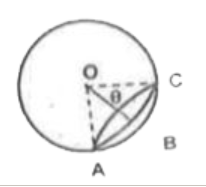The time period of oscillation T of a small drop of liquid under surface tension depends upon the density ρ, the radius r and surface tension σ. Using dimensional analysis show that T∝√ρr3σ
To solve the problem using dimensional analysis, we need to express the time period T in terms of the given quantities: density ρ, radius r, and surface tension σ. We will follow these steps:
Step 1: Identify the dimensions of the given quantities
1. Density ρ: The dimension of density is given by mass per unit volume.
(ρ)=ML−3
2. Radius r: The dimension of length is simply:
(r)=L
3. Surface tension σ: Surface tension is defined as force per unit length. The dimension of force is mass times acceleration, which can be expressed as:
(σ)=(F)(L)=MLT−2L=MT−2
Step 2: Formulate the expression for T
We assume that the time period T can be expressed as a function of ρ, r, and σ:
T∝√ρrnσm
where n and m are the powers we need to determine.
Step 3: Write down the dimensions of the right-hand side
The dimensions of the right-hand side can be expressed as:
(√ρrnσm)=√(ML−3)(Ln)(MT−2)m=√ML−3+nMmT−2m
This simplifies to:
√M1−mL−3+nT2m
Step 4: Set the dimensions equal to those of T
The dimension of time period T is:
(T)=M0L0T1
Setting the dimensions equal gives us:
M1−mL−3+nT2m=M0L0T1
Step 5: Solve the equations for n and m
From the equality of dimensions, we can form three equations:
1. For mass M:
1−m=0⟹m=1
2. For length L:
−3+n=0⟹n=3
3. For time T:
2m=1⟹m=12 (already satisfied)
Step 6: Substitute n and m back into the expression
Now substituting n=3 and m=1 back into our expression for T:
T∝√ρr3σ
Conclusion
Thus, we have shown that the time period of oscillation T is proportional to:
T∝√ρr3σ
(ρ)=ML−3
(r)=L
(σ)=(F)(L)=MLT−2L=MT−2
T∝√ρrnσm
where n and m are the powers we need to determine.
(√ρrnσm)=√(ML−3)(Ln)(MT−2)m=√ML−3+nMmT−2m
√M1−mL−3+nT2m
(T)=M0L0T1
M1−mL−3+nT2m=M0L0T1
1−m=0⟹m=1
−3+n=0⟹n=3
2m=1⟹m=12 (already satisfied)
T∝√ρr3σ
T∝√ρr3σ
Topper's Solved these Questions
- BOOK - ICSECHAPTER - DIMENSIONSEXERCISE - SELECTED PROBLEMS (FROM CONVERSIONS OF ONE SYSTEMS OF UNITS INTO ANOTHER)9videos
DIMENSIONS
- BOOK - ICSECHAPTER - DIMENSIONSEXERCISE - SELECTED PROBLEMS (FROM FINDING THE DIMENSION OF A PHYSICAL QUANTITY)3videos
DIMENSIONS
- BOOK - ICSECHAPTER - COMPETITION CARE UNITEXERCISE - OBJECTIVE QUESTIONS FROM PREVIOUS IAS EXAMINATIONS50videos
COMPETITION CARE UNIT
- BOOK - ICSECHAPTER - DYNAMICSEXERCISE - SHORT ANSWER QUESTIONS WITH ANSWERS12videos
DYNAMICS
Similar Questions
Knowledge Check
- Question 1 - Select One
The work done to blow a scap bubble of radius. R (surface tension T)
A4πr2TBπr2TC2πr2TD8πr2T
Time period of an oscillating drop of radius r, density ρ and surface tension T is t=k√ρr5T. Check the correctness of the relation
View SolutionIf the time period (T)of vibration of a liquid drop depends on surface tension (S) , radius(r) of the drop , and density (ρ) of the liquid , then find the expression of T.
View SolutionA needle of length l and density ρ will float on a liquid of surface tension σ if its radius r is less than or equal to:
View SolutionThe time period of a soap bubble is T which depneds on pressure p density d and surface tension s then the relation for T is
View SolutionConsider a small water drop in air . If T is the surface tension , then what is the force due to surface tension acting on the smaller section ABC ?
 View Solution
View SolutionIf T1 and T2 are the time-periods of oscillation of a simple pendulum on the surface of earth (of radius R) and at a depth d, the d is equal to
View SolutionThe time period (T) of small oscillations of the surface of a liquid drop depends on its surface tension (s), the density (ρ) of the liquid and it's mean radius (r) as T=csxpyrz. If in the measurement of the mean radius of the drop, the error is 2%, the error in the measurement of surface tension and density both are of 1%. Find the percentage error in measurement of the time period.
View Solution

